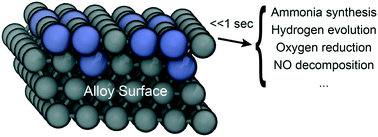Abstract
Intensive research in catalysis has resulted in design parameters for many important catalytic reactions; however, designing new catalysts remains difficult, partly due to the time and expense needed to screen a large number of potential catalytic surfaces. Here, we create a general, efficient model that can be used to screen surface alloys for many reactions without any quantum-based calculations. This model allows the prediction of the adsorption energies of a variety of species (explicitly shown for C, N, O, OH, H, S, K, F) on metal alloy surfaces that include combinations of nearly all of the d-block metals. We find that a few simple structural features, chosen using data-driven techniques and physical understanding, can be used to predict electronic structure properties. These electronic structure properties are then used to predict adsorption energies, which are in turn used to predict catalytic performance. This framework is interpretable and gives insight into how underlying structural features affect adsorption and catalytic performance. We apply the model to screen more than 107 unique surface sites on approximately 106 unique surfaces for 7 important reactions. We identify novel surfaces with high predicted catalytic performance, and demonstrate challenges and opportunities in catalyst development using surface alloys. We also share an implementation of our model. This work shows the utility of a general, reusable model that can be applied in new contexts without requiring new data to be generated.



 Please wait while we load your content...
Please wait while we load your content...